Give a Black Dog a Chance
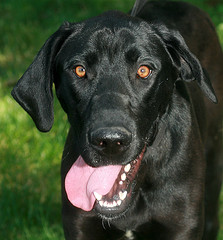 Have you ever heard of the BBD Syndrome? No, it’s not a recognized disease that is attacking the pet population, but it is killing many, many dogs nonetheless. BBD stands for Big Black Dog. A large black dog in a shelter, particularly Labrador mixes, has very little chances of getting adopted and most of them end up euthanized. And keep in mind this happens with cats as well. These are animals that do not have any personality problems. Some of them, are loving, sweet, well trained, intelligent, with wonderful temperaments. Their only “flaw”? They are black. And no, we are not talking about adorable tiny black Poodles or Chihuahuas, we are talking about gorgeous Labradors and German Shepherds that are put to death simply because of their color.
Have you ever heard of the BBD Syndrome? No, it’s not a recognized disease that is attacking the pet population, but it is killing many, many dogs nonetheless. BBD stands for Big Black Dog. A large black dog in a shelter, particularly Labrador mixes, has very little chances of getting adopted and most of them end up euthanized. And keep in mind this happens with cats as well. These are animals that do not have any personality problems. Some of them, are loving, sweet, well trained, intelligent, with wonderful temperaments. Their only “flaw”? They are black. And no, we are not talking about adorable tiny black Poodles or Chihuahuas, we are talking about gorgeous Labradors and German Shepherds that are put to death simply because of their color.
Some black dogs are taken by rescue groups from shelters before they end up in death row, knowing full well that it make take months, and sometimes even years to find a home for those animals. Some groups don’t even accept black dogs because they are so impossible to place.
The reason is that there are many misconceptions and myths about black dogs, and when people come to the shelter or decide to adopt from a rescue group, they tend to gravitate towards lighter colored dogs, even if it’s unconsciously. Black dogs are regarded as bad dogs, vicious or dangerous. Unfounded superstition, literature and folklore have all conspired to give the black dogs a bad rep. Winston Churchill used to call his depression “the black dog”. The devil was represented by a black Rottweiler in “The Omen”. TV and film tend to portray black dogs as evil. There are legends where ghosts of black dogs haunt the  roads, believed to be restless wicked souls . But these are all just that: myths, legends and superstitions. I would truly think that saving the life of an animal who is destined to get killed would actually bring good luck to the person who did it. Black dogs are just that, dogs that happen to have black fur.
roads, believed to be restless wicked souls . But these are all just that: myths, legends and superstitions. I would truly think that saving the life of an animal who is destined to get killed would actually bring good luck to the person who did it. Black dogs are just that, dogs that happen to have black fur.
Shelters do their best to get their black dogs noticed, dressing them up with bright colored bows, or putting colored blankets in their cages. They often try to get the potential parents to consider a black dog, but when people see so many black dogs still in their cages they can’t help thinking there might be something wrong with them. Adoption fees are sometimes lower for black dogs.
So now that you know, you can all help save many lives if you consider adopting a black dog if you decide to get a life companion. Pass the word, talk to your friends. There might be a wonderful friend with a bright black coat waiting to share its live with them.
Visit this site if you want more information: Black Pearl Dogs
Photos courtesy of:
When There is Blood in a Dog’s Stool
Yeah, it can be quite a scare, but when there is blood in a dog’s stool and it doesn’t always mean a trip to the emergency clinic. But, when should you really worry? Well, it all depends on the general state of the dog.
Do you notice a decrease in energy?
Has she been vomiting?
How much blood was in the stool?
Does he hurt when you push on his belly?
Is her belly swollen?
Has he ingested something like antifreeze, plants or any other substance?
Has she had diarrhea for more than a day?
Does his anal glands look swollen?
If any of the above is happening and the dog is NOT acting normal, then a prompt trip to the vet is totally necessary to make sure it’s not something more serious than having eaten a small bone in the park. But if the dog is active, and eating well and acting as his old self, then you could keep an eye on him for the next few days to see if it happens again. If it doesn’t happen again, you don’t have to rush to the clinic, but make sure to have your vet give him a checkup as soon as possible.
Sometimes dogs will swallow a piece of bone, or a toy or something that scratches the walls of their large intestines, causing him to pass blood in the stool. The blood might appear in the stool for a couple of days, but then it should go away. If it doesn’t, an x-ray might help you see if something is stuck in there. Surgery might be necessary to remove the object.
Parasites can also be the cause of blood in the stool as they irritate the intestine walls. Parasites can be treated with the right medication.
He could have developed an allergy to the food he’s been eating, or there might have been a sudden change of diet.
It could be an infection of the anal sacs. These sacs are located on either side of the anus and they contain a substance with which dogs mark their territory. They get emptied every time your dog poops, however, sometimes they can get infected if they don’t get emptied completely.
Blood can also be cause by an inflammation of the colon or rectum, or a benign or malignant tumor in the abdomen or anal area.
Worst case scenario, it could be Parvovirus or Coronavirus, especially if the dog’s been vomiting as well. These diseases can be very serious, even fatal.
The medical terms for blood in dog stool are hematochezia or melena. In hematochezia, the blood will look fresh and bright red, which means that the blood in the dog’s stool comes most probably from the lower intestines, the colon or the rectum. Hematochezia in dogs can be a sign of a minor problem, but it can also point to a more severe disorder.
In melena, the dog’s stool looks black, which means the blood is digested and comes from the upper intestinal tract. Melena is more serious than a periodic case of hematochezia. If in the past day or so, you gave Peptobismol to the dog, maybe you have nothing to worry about, since Pepto can be the cause of black dog stool.
In any case, blood in the dog’s stool should not be taken lightly and you should always take him or her to the vet as soon as possible. In the meantime, you can feed them white rice with a little garlic or garlic powder mixed in, boiled potatoes, green beans, or a little boiled chicken. Avoid commercial foods until you are sure of what’s going on.
Photo courtesy of:
Safety Tips for Kids and Dogs
Children love dogs and dogs usually love children. When the two can interact safely and happily, it’s a beautiful thing to watch. Dogs can be wonderful friends and protectors for children while children can learn a great deal about how to be gentle, loving, and responsible dog owners. To reach that level and to gain those benefits, however, you’ll need to teach both the animal and the child how to safely interact.
Here are a few tips to make that happen.
Socialize the dog
A well-socialized dog is going to be less nervous and excited around children. You should start taking your dog or puppy to places where children will be present so they can get accustomed to the noise, the fast movements, and the heightened excitement. That can all be a lot for a dog and can cause him to become too excited or too nervous. If he is used to these things, he’ll be more likely to be calm when petted and adored by admiring children.
Teach your children
Children, as mentioned above, love dogs and sometimes they love them so much that they act without thinking. A little hand reaching tentatively to touch a dog’s head could easily get bitten by an unfriendly or poorly socialized dog. Children, for this reason, should always be taught to ask the dog’s owner before petting the animal. That gives the owner a chance to properly prepare the dog for the attention and to refuse if he or she knows the dog is not a big fan of children. Plus, it means your little one won’t be rushing up to dogs and putting themselves in a situation where a startled dog might attack.
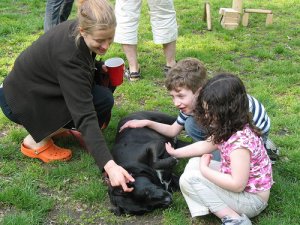 Teach the dog good manners
Teach the dog good manners
Just as children need to learn to ask before petting a strange dog, dogs should be taught good manners in public. If someone approaches him, the appropriate way to handle the attention is for him to sit or to lie down. This keeps the dog in a more controllable position for you and makes him see very well-behaved. Plus, if you take the time to sit the dog, the children can have time to calm down and the situation can be easier to manage. Also, you must teach your dogs, especially the larger ones, not to jump up on people as a greeting. This can be cute, but it is also very dangerous for children who can easily be knocked over by the weight of the dog.
Help children learn not to hurt animals
Sometimes children don’t understand the proper way to treat animals, including dogs. Kids may grab their tails or try to climb onto of them without thinking about the discomfort this could cause the dog. Small dogs can be injured, placed in toy boxes, or more. For the dog, these are negative experiences that make them dislike being around the child. As a parent, you should stop your children from engaging in these activities at the earliest sign of them. Teach your kids from day one how to treat the dogs appropriately. Also, be a good role model. If you hit your dog to punish him or her, you are sending a very dangerous message to your child.
The bottom line is that both dogs and children need a little bit of training in this area. They need to be socialized so they can get along with one another, and they need to learn the appropriate ways to respond to one another. With a little help, they can have a great relationship that is safe and loving.
When Does Your Dog Need to See a Vet
Some dog health issues must be addressed by a qualified veterinarian. Having a good vet in your corner, one who you know and trust is priceless and it’s very reassuring.
Flea Control and Worming:
Controlling fleas and worms is an important health issue that your Vet can assist you with. Fleas are an obvious problem, but there are also heartworms, tapeworms, roundworms… your vet will recommend a treatment to follow and you have to stick with it. You will probably need to administer monthly worming tablets (which they love!) and maybe other medication.
Annual Check Up:
It’s a good idea to schedule an annual check up or “wellness test”. Your Vet will conduct a series of tests which is a great proactive and preventive health measure. A good Vet will be able to spot any irregularities in the test results and will also check your dog for any sign of breed specific health problems. Educate yourself about dog diseases like Cushing’s and Addison’s. Sometimes these diseases sneak up on you and you don’t realize it until it’s too late and complicated to treat.
Vomit:
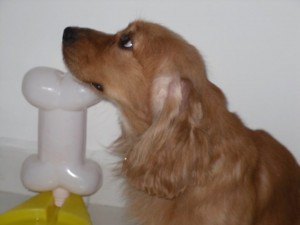 If your dog vomits once, take certain precautions within your household to avoid it from happening again. However, if your dog frequently throws up, has chronic diarrhea, has bloody stools (bloody stools look like coffee grains), if the dog’s stomach is swollen, or if he has a fever or appears to be ill, you must call your veterinarian right away. Even if your dog doesn’t have these symptoms, but has been vomiting frequently, it’s very important to call the vet at once. Dogs can become quickly dehydrated and this can cause serious problems to their health. Frequent vomiting can indicate other serious health problems like gastroenteritis, gastric ulcers, tumors, or intestinal obstructions. Parasites can also cause a dog to vomit because they proliferate so rapidly that they can actually block the dog’s gastrointestinal track.
If your dog vomits once, take certain precautions within your household to avoid it from happening again. However, if your dog frequently throws up, has chronic diarrhea, has bloody stools (bloody stools look like coffee grains), if the dog’s stomach is swollen, or if he has a fever or appears to be ill, you must call your veterinarian right away. Even if your dog doesn’t have these symptoms, but has been vomiting frequently, it’s very important to call the vet at once. Dogs can become quickly dehydrated and this can cause serious problems to their health. Frequent vomiting can indicate other serious health problems like gastroenteritis, gastric ulcers, tumors, or intestinal obstructions. Parasites can also cause a dog to vomit because they proliferate so rapidly that they can actually block the dog’s gastrointestinal track.
Torn nail:
Dogs romp and stomp and have fun until they snag a nail. Then the howling and bleeding begin. See if you have a styptic pencil handy, or you can use corn starch if you don’t, to stop the bleeding and put a bandage on the injury and go to your vet. But if there is a lot of blood, a visit to the emergency room is the safest bet.
Insect bites or stings:
Sometimes you don’t even notice an insect bite on your dog, however, they can be very serious if the animal is hyper-sensitive or allergic. If left untreated, the dog’s breathing could become affected.
Eye trauma:
This is always an emergency. When an animal gets poked or scratched in the eye or has an eye infection, it likely will get worse without treatment.
By the way, don’t let your dog hang his head out the car window. They can get debris or bugs in their eyes. If your pup insists on having the breeze in his face, it’s a great excuse to train him to wear a pair of specially designed pet goggles.
Abrasions:
Clean the wound and protect the lesion with topical antibiotics and cover it with a bandage. But a lesion like that can cause your pet to lick or scratch excessively and lead to infection. Call your vet to get advice. Your pet could benefit from pain relief and might even need to wear an Elizabethan collar to protect the lesion… but don’t worry, there are alternatives to the dreaded collar.
Punctures:
Your dog may step on a nail, brush against a tree or get caught while climbing under a fence and could get a splinter or tear his or her skin.
Snake bite:
This isn’t a huge issue for a city dog, but if you travel or go camping with your pet, you have to think about it. When camping, check with park rangers to see if rattlesnakes (or other biting snakes) are in the area. Try to keep your pet as immobilized as possible to prevent the rapid spread of the venom, and take him or her to a vet.
Emergency!
In the unthinkable case of serious injury or illness, you will need a vet who you trust and can rely on to save your dog’s life. It helps if the vet is familiar with your dog. Do good research when choosing a vet. Consider one who is open long hours and has the ability to perform emergency surgery should the need arise.
Advantages of Obedience Training
When you bring home a new puppy or dog, especially if you are a first time dog owner, it’s a good idea to sign up for obedience classes.
It’s important that your dog has good manners. That means he or she needs to learn some basic commands: sit, stay, come, down, and others. By teaching your dog these commands, you should have more control over him or her during social situations.
When attending obedience classes, you will have a good opportunity to begin developing the appropriate roles for you and your dog. You love your canine companion, but that doesn’t mean you shouldn’t let him or her know who is in charge in the relationship. After all, you love your children but you let them know you are in charge.
Another reason to consider obedience classes is the socialization you can achieve. Most obedience classes involve group classes. This gives the pet an opportunity for socializing in a controlled environment and also gives you a chance to practice the commands when a lot of distractions are present.
In some cases, obedience trainers may be able to offer some strategic suggestions for dealing with common puppy or dog behavior problems, such as barking or chewing.
Don’t rely on the obedience classes alone
While an obedience program can help you learn useful commands to use with your dog, a lot of people who complete these training programs get lazy after finishing them. They don’t consistently use those commands once training is finished. Without following through, the training is useless.
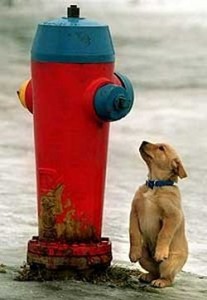 You need to make sure you continue working with the commands on an ongoing basis… 5 to 15 minutes a day is all it takes to really drive home those commands.
You need to make sure you continue working with the commands on an ongoing basis… 5 to 15 minutes a day is all it takes to really drive home those commands.
Keep in mind that sometimes obedience programs don’t allow the dogs to learn at their own pace. While most dogs can pick up on commands relatively quickly, some commands or tricks may take longer to learn for some dogs than others. For example, some dogs are very resistant to the “Come” command while others have no trouble mastering it in a short time. So if your dog doesn’t pick up on something immediately, make sure you practice that particular command often until they learn what they need to know. Once the obedience classes are over, keep training on your own, you can work at your dog’s pace and can save both of you a lot of frustration.
If you decide to use obedience program, research what kind of training that particular group uses. They are not all created equal. You also want to make sure the program provides socialization time. Even though this is one of the best reasons to go through an obedience program, not all of the providers offer this option. Always ask before you sign up. Keep searching until you find one that truly serves your needs.
Always remember that your dog loves to learn, and one you learn how to teach him something, it will be a breeze to teach him anything you want. You will have fun together and a wonderfully behaved dog!
Crate Training An Older Dog
You bring home your new canine friend and now it’s when the work begins. While it would be wonderful to cuddle with him or her forever, and just play and enjoy him, this is the time to housebreak him and the best way to do this is with the use of a crate or doggie den. And it doesn’t matter if you bring home a young or an adult dog.
You dog won’t hate you for putting him in a crate if you do it right.
Crate training is based on the idea that dogs carry many of the same instincts as their ancestors, including wolves and wild dogs. Two of those instincts are not to go to the bathroom in your living area and to have a small living area that will offer you protection (aka a den). In the wild, animals do not use the bathroom near their living quarters probably because they realize at an instinctual level that doing so is unhealthy and because the odor is going to attract predators. In the wild, you also want a safe and cozy place to call home.
The crate allows you to use these two instincts to potty train your new pal. The crate acts as the protective den for the dog. He or she may not enjoy it at first, but will eventually come to see it as a place of safety and peace. Because the dog is also going to be considering it a den, she’s not going to use it as a toilet either.
How Does it Work?
Confining your dog for a while allows you to sort of predict when he wants to go, so you will be there to take him directly to the appropriate spot and reward him handsomely for doing the right thing in the right place. Once he’s used to going to that spot, the crate won’t be necessary, but it will remain there for him to hide or have quiet times, or you can use it to travel and take him places, knowing he’ll be comfortable inside his little den.
What Kind of Crate to Use?
There are different types of crates for dogs available. Some are made from metal and are more open so the dog can see around him. Others are made from hard plastic and have a metal door on the front. The latter is the type used to fly your dog on an airplane.
Regardless of which type you choose, you want to get a crate that is only large enough for your dog to stand, lie down and turn around in. You don’t want to have too much extra room or else the dog can use part of the crate as a bathroom and defeat the entire purpose.
Associate the Crate with Positive Things
Don’t assume your dog is going to recognize immediately that the crate is his or her new den. You’ll have to make the dog associate being in the crate with something positive, such as tasty treats, favorite toys, and lots of praise. Do this very slowly and avoid leaving the dog alone in the crate for too long before he has become accustomed to it. Negative experiences will make the whole process take longer.
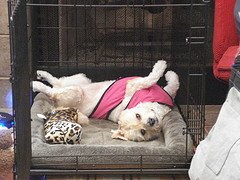
Emanuelle
You should also give no affection or attention to the dog if she’s whining in the crate. Your natural impulse will be to comfort her but this will only make things worse. Also, do not let her out of the crate until she’s quiet. Otherwise, you’ll be rewarding an undesired behavior.
You should put the crate in an area where your family or yourself spend a lot of time, never put it in an isolated place. Put a cushion or a soft blanket inside. Now bring your dog over with lots of praise and a playful tone. Open the door of the crate and secure it so it won’t close accidentally.
Now, she has to go into the crate on her own, so encourage her with treats. You can drop some just outside, and leave a trail up to the back of the crate. The goal is to make her go in on her own. This can take a while, so be patient and never force her!
Once she goes in once, you can try to start feeding her right next to the crate, and slowly move her dish all the way to the back of the crate. Once she’s comfortable eating all the way inside, start closing the door while she eats and opening it as soon as she’s done.
Every time you do this without her getting anxious, increase the time you leave the door closed. If she starts whining, maybe you left it closed too long. Try shortening the time the next time.
But remember: do not open the door when she’s whining or you’ll ruin everything!
Once she’s used to that, start calling her and giving her a treat to go inside. Close the door and stay with her 5 to 10 minutes, then to another room for a few minutes, return and sit quietly a little while longer. Do this a few times a day if possible.
When your pal is used to the crate, start feeding her inside and then wait an hour or so to take her out after her meal, and take her to her potty spot. Wait until she goes. And when she does, give her a treat and then take her for a walk! The walk will be her reward! If you walk her first and then you take her inside after doing her thing, she might get the idea that her walk is over when she goes and you can seer the problem there, right?
This is perfect especially for dogs that live in apartments. They can learn to go on their potty tray, and then the walks are just the icing to the cake! Whatever your circumstances, give crating a try.
Exercising Your Dog
Dogs need their exercise just like people do. Regular exercise helps your dogs maintain a healthy weight and strengthen their muscles. It also keeps them from getting into mischief around your home due to all of that pent up energy. Ask anyone with a well exercised dog and they will tell you their home is a more peaceful place.
But most people don’t know what it takes to provide their pets a good exercise routine. They have lots of questions and may not want to spend the time, or simple, never thought of asking their vet. If you’re one of those people, you’ve come to the right place. Here are some tips to help you make the most of exercising your dog safely.
Variety is Key
While walking your dog is one of the most common exercise methods, it’s not the only one you can use. In fact, it might not even be the best choice for some dogs that have a lot of energy to get rid of unless you’re prepared to do a lot of walking, or jogging.
For high energy dogs, you might consider biking or roller blading as alternatives to just ordinary walking. You do want to make sure that your dog is good on a leash before you try these alternatives, otherwise, you could put both of you in a dangerous situation. There are special accessories for your bike that you can use to hold the leash, while stopping the dog from crossing your path and getting hurt. And if you roller blade, make sure you get a leash that is easy to hold on to.
Another option is swimming. Dogs and humans can get a lot of exercise from swimming. This might be a good choice for older dogs that need to give their muscles a little bit of a rest or as an alternative in warm environments. Not all dogs take to the water well. A friend of mine had a Great Dane who wouldn’t get in the water no matter what, but you couldn’t get her Saint Bernard out of any pool, fountain, or puddle it found. This is obviously doable if you have your own pool, or if you are lucky enough to live in an area with a public dog pool or a lake where dog swimming is allowed.
You can also use dog parks and games, such as fetch, to help exercise your dog. However, you don’t want to rely solely on these methods. Exercise time can be a good time to exert your role as the leader and to exercise your dog’s mind as well as his or her body.
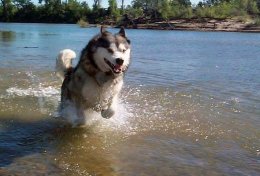
Rupert
If you have a high energy dog, you may also be able to use a treadmill in your home to help them relieve that energy. You’ll need to help your dog feel comfortable using the exercise equipment first. Once your dog is comfortable he or she will enjoy using the treadmill. It can be a good alternative when you are short on time or when the weather outside is too hot for safe exercising.
Tips for Exercising
First, you have to think about your dog when you are determining the right type of exercise for him or her. A small dog still needs to exercise, but it won’t require as much to drain his energy. A short jog might be sufficient. If you have larger dogs, they may need to exercise more but many of these big breeds get tired pretty quickly, too. Just remember to pay attention to your dog and listen to them when they say they’ve had enough.
Second, make sure your dog stays well-hydrated. In the heat, dogs can get overheated pretty quickly. Always have fresh, cool water available for your dog during or right after exercise. If your dog does get a little overheated, bring out the hose and wet them down. The cool water on their bodies, especially their paws, can help them cool down quickly.
You should also avoid feeding your dog 30 minutes before and 30 minutes after exercise to prevent vomiting or nausea.
Socializing Your Puppy or Dog
When you have a child, you have a responsibility to introduce him or her to a wide range of people and experiences to better prepare them for the world. The same is true when you have a puppy or a dog. This process is known as socialization. Let’s look at some of the reasons why this process is so important and how you can be sure to properly socialize your canine companion.
Good Reasons to Socialize
If you’ve seen aggressive dogs before, you’ve also seen the consequences of poor socialization. When dogs haven’t been introduced to these new experiences, they become fearful and anxious when encountering them. Just think of how you felt on the very first day you ever worked at a job or the first day you went to school.
Socialization, therefore, helps make dogs more comfortable when they have these experiences, such as meeting a new dog at the pet store or being petted by children or riding in the car. Positive early experiences are the best way to prevent future anxiety and aggression problems in your dog.
Another good thing about socialization is it helps you meet new people and have new experiences. Taking your dog to the park, for example, is a great way to start up conversations with people if you are normally a shy person.
Methods of Socialization
Obviously, the best time to start is when the puppy is very young. Take him or her with you whenever you can, and let people approach and pet him. Take him to the puppy education classes of your local pet shop where he will interact with other puppies. Take him to the small dog area of your local dog park. See how he reacts, how he acts, and get to know him well.
If you adopted an adult dog, hopefully he will have been exposed to other people and dogs in positive situations, but you still have to see for yourself how he reacts around people and animals.
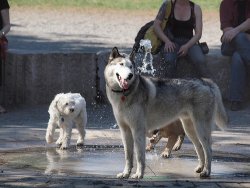
The most important part of the socialization process is the positive experience. If you take your dog to the dog park for the first time and the experience is horrible, she is going to be more reluctant to return the second time. She may be fearful or anxious which could lead to another bad experience. Before you know it, the dog park is off limits. You obviously don’t want that to happen.
So, take her at a time when there are not a lot of dogs around. Don’t bring her in with the leash on. By now you should know how she reacts to other dogs she might have encountered on her walks. If she tends to be aggressive, you might need to do some training before exposing her to a large dog park. How can you guarantee a positive experience? Remove your own fear and nervousness about the situation. If you’re nervous, your dog will be, too. Always be positive and assume that the experience is going to go well.
Another way to do it is taking him to the pet shop, where she or he will probably encounter other dogs. When you go to the pet store, keep your dog on leash at all times (and do not use extensible leashes) and pay attention to his or her behavior. A dog that starts acting nervous or becomes very alert needs to be corrected immediately.
If your dog becomes nervous under certain circumstances, it’s a good idea to calmly make him or her confront what is causing the nervousness… unless it is a real threat. If you’re walking your dog on the sidewalk and a city bus drives by and startles your dog, the next time a bus comes, make him sit instead of letting him hide from it. Have him sit until the bus passes and then praise him like crazy. Now, if an unleashed, threatening dog were approaching you, this would require a different tactic and would not be the best time to confront the problem.
The important thing is to have your dog encounter as many new experiences and people as possible. Walk him or her in different locations: your neighborhood, the park, the river, around shopping areas that permit dogs, near roads, around noisy areas, and around quiet areas. You also want your dog to interact with other animals and people, including people of all types and ages. Make sure your dog is also socialized to lots of experiences, including riding in the car, having his feet touched, being groomed, getting a bath, being petted, and more.
The bottom line is that thorough socialization does take time and commitment from you, but the results are well worth the effort.
The Benefits of Using a Dog Park
Dogs of all ages need exercise. Nothing can replace a good walk with a human companion, but all dogs really want a chance to run and really stretch their legs. If they can enjoy the camaraderie of other canines at the same time, that’s even better. And that’s why dog parks are such a great place for your pets.
Let’s look at some of the good reasons to use your local dog park, as well as a few precautions you should be taking, too.
Socialization Galore
If you’re fortunate enough to have a popular dog park in your community, this can be a great source of socialization for your dog. Dogs need to have as many interactions as possible with other dogs and with humans so they will feel comfortable in lots of different situations. A well-socialized dog is less likely to be anxious, nervous, or aggressive. Because a dog park is full of people and pets, socialization is almost guaranteed.
Fun for Dogs of All Types
Dogs love to walk and explore their environment, but they may not always like having to be leashed in the process. Even if you have a big fenced in yard where your dog can run safely unleashed, if he or she doesn’t have a buddy to chase around the fun may be limited. At the dog park, dogs can do their own thing off-leash. Older dogs might just want to find a shady spot under a tree. Active dogs may want to play as a pack. Some dogs may want to play fetch with their human companions.
If you’ve never seen the pure look of happiness on the face of a dog running off-leash, you need to head to the nearest dog park and see it for yourself.
Healthy Exercise
Another benefit is the exercise for your dog. Dogs who don’t get enough exercise are prone to obesity, arthritis, and other serious health problems. Plus, they are more difficult to live with because all of the pent up energy is going to emerge as destructive, unwanted behavior in your home.
While walking your dog is good exercise for both of you, the dog park is going to give your dog a chance to really get a workout and drain that energy. Regular visits to the dog park will make a huge difference in even the feistiest dog.
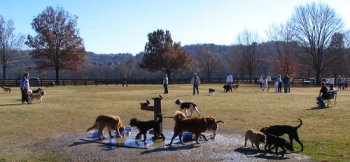
A Few Precautions
Dog parks clearly have a lot of benefits, but you do need to take some precautions for your pet’s protection and your own.
1. Separate Small and Large Dogs – Most dog parks have separate areas so small dogs can enjoy themselves safely. Large dogs, even the friendly ones, can accidentally injure a small dog. Obey the rules on separation by size, and if your particular park does not offer that option, start campaigning in order to have the city establish it.
2. Look Around – Always keep an eye out for dog fights, which will undoubtedly happen once in a while. If you know the park well, be aware of new dogs coming into the park and their general demeanor.
3. Keep Your Dog Under Vocal Control – Even though the dog park is a place where humans can mingle, too, you don’t want to become so distracted in your conversation that you can’t pay attention to what your dog is doing. Most dog parks do have rules requiring you to have vocal control over your dog at all times.
4. Keep Your Eyes Open – The dog park will give you a chance to socialize with other dog owners, however, always keep your dog in sight. Be aware of other dogs getting aggressive, or even of what he get’s into his mouth. One of the ways to keep the parks pleasant, is for the owners to always pick up after their dogs. Don’t be so distracted that you don’t see when your dog does its business.
5. Bring Water – Although some dog parks do have the ability to provide water for the dogs through a fountain, most do not. Always bring along water for your dogs because the can easily get overheated when they’re playing in the warm sunshine. In the summer, you might find the best times to play are in the morning and in the evening before sunset.
6. Protect Yourself – Getting to know your fellow dog lovers is a great idea but you have to be careful. Just because someone owns a dog that doesn’t mean they are a wonderful person. Be careful about how much personal information you reveal about yourself. Do not leave your purse or wallet visible in the car while you are inside the park. Would be thief knows you’ll be distracted and will take advantage of the fact.
Most importantly, use this play time to bond with your dog. Don’t just get there and ignore him or her the rest of the time. Nothing will make your dog happier, than having the chance to play with you.
Neutering or Spaying Your New Dog
If you are having doubts about neutering or spaying your new dog, you have to consider the benefits for his or her health and for both your lives.
Male dogs are not “manly” and female dogs do not “need” to have puppies.
There are people (usually men… no offense, guys) that actually think that keeping their dog’s testicles intact is manly, both for the dog and for the owner… sometimes, people go as far as to have prosthetic testicles inserted for their neutered dogs. To each it’s own, but… really?
Also, breeding a dog is not necessarily better for the animal, neither male nor female, and it certainly can make dogs much more difficult to manage if they are not neutered.
Unless there is a specific reason to breed your dog, it should be neutered or spayed at an early age to prevent pregnancies, avoid aggressive male behavior, and even lessening the possibilities of some forms of cancer.
It’s normally recommended that the dog gets neutered between 2 and 6 months old. Of course, there is always a small risk associated with any sort of surgery, but it’s riskier to own a dog with an aggressive sex drive. Another reason to do it early, is that younger pups manage through the surgery option much better than older dogs. The surgery is very simple and can be performed in a matter of minutes.
Now, let’s clarify some myths:
Early neutering or spaying does not stunt growth. That’s a myth propagated by breeders and others who don’t want to spay their animals.
Your dog will not get fat and lazy after being spayed or neutered unless you feed him/her too much.
What happens if your male dog is not neutered?
-They will pee on everything they find on their way: furniture, curtains, shoes, clothes, walls… you get the idea.
-Dogs might be aggressive to other dogs and also hump even other male dogs. Just this fact should give you an idea of what kind of aggression can develop in those circumstances, besides, it’s very embarrassing.
-Even dogs that normally have the most wonderful temperament, can get aggressive towards humans and other dogs. A male will actually attempt to kill any male who he thinks will mate a bitch near him.
Don’t be kind to your dog by “letting try it out at least once”. Once a dog has actually had sex, his behavior can be magnified significantly when coming in contact with fertile bitches.
When a male dog is after a fertile female, breeding is the only thing on his mind. He will do anything that he can think of to get to her: scaling fences, breaking down doors, mating through fences, digging, etc. Besides risking getting sued for any damage, another thing to consider is that you are as responsible as the owner of the female for any puppies that are born.
What happens if your female dog is not spayed?

Rovespierre
-First, you can count on having her locked up twice a year to keep her away from all those dogs that I mentioned before.
-Her risk of mammary cancer doubles, although it doubles from almost nothing to very low with only one heat, it climbs quickly thereafter till after 5 heats as it starts to approach 50%. Be very careful that you don’t allow a mating when she gets her first heat because this can be life threatening. It is very important to spay her before the first heat.
-A brother and sister from the same litter can create their own litters by the age of five months. It is not a good idea to allow this to happen.
-Male dogs can sometimes be quite aggressive to a female in season.
-Your house will be a mess, and her behavior will drive you crazy.
After reading all this, you need to ask yourself, “is it really worth it?”
Frankly, in the 99.99% of cases, it is not.
Don’t wait until your dog starts getting sexual drives before you neuter him. In many cases, once the dog starts the misbehavior associated with attempting to breed, that behavior can stay even after the neutering has taken place.
Do yourself, your family, your neighbors and your beloved dogs a favor by getting them spayed and neutered.


